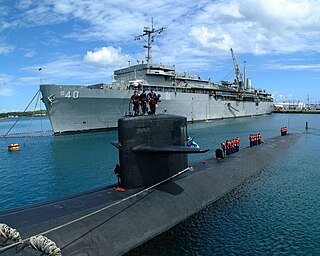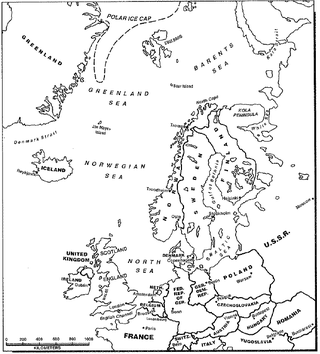
A submarine tender, in British English a submarine depot ship, is a type of depot ship that supplies and supports submarines.

Regele Ferdinand (F221) is a Type 22 frigate of the Romanian Naval Forces, formerly a Royal Navy ship named HMS Coventry (F98). She was originally intended to be named Boadicea but was named Coventry in honour of the previous Coventry, a Type 42 destroyer sunk in the Falklands War. Following service in the Royal Navy she was sold to the Romanian Navy in 2003.

HMS Chatham was a Batch 3 Type 22 frigate of the British Royal Navy. She was decommissioned on 8 February 2011.

USS Monterey (CG-61) is a Ticonderoga-class guided-missile cruiser that served in the United States Navy. She is the fourth US Navy vessel named for the Battle of Monterrey at Monterrey, Nuevo León during the Mexican–American War in 1846. She was built at Bath Iron Works in Maine. The ship was decommissioned on 16 September 2022.

USS Nicholson (DD-982), a Spruance-class destroyer, was the fourth ship of the United States Navy to be named for a family which was prominent in early American naval history, including James Nicholson, the senior Continental Navy Captain, and Samuel Nicholson, the first captain of USS Constitution.

Standing NATO Maritime Group One (SNMG1) is one of NATO's standing naval maritime immediate reaction forces. SNMG1 consists of four to six destroyers and frigates. Its role is to provide NATO with an immediate operational response capability.

Operation Deliberate Force was a sustained air campaign conducted by NATO, in concert with the UNPROFOR ground operations, to undermine the military capability of the Army of Republika Srpska, which had threatened and attacked UN-designated "safe areas" in Bosnia and Herzegovina during the Bosnian War with the Srebrenica genocide and Markale massacres, precipitating the intervention. The shelling of the Sarajevo marketplace on 28 August 1995 by the VRS is considered to be the immediate instigating factor behind NATO's decision to launch the operation.

HMCS Algonquin was an Iroquois-class destroyer that served in the Royal Canadian Navy (RCN) from 1973 to 2015.

Naval tactics and doctrine is the collective name for methods of engaging and defeating an enemy ship or fleet in battle at sea during naval warfare, the naval equivalent of military tactics on land.

Operation Active Endeavour was a maritime operation of the North Atlantic Treaty Organization. It operated in the Mediterranean Sea and was designed to prevent the movement of terrorists or weapons of mass destruction. It had collateral benefits in enhanced security of shipping in general. It was one of the first military actions taken by NATO in response to an invocation of Article 5 of the North Atlantic Treaty which provides for collective defense and the first-ever operation conducted by the Alliance in direct application of the defense clause of the Treaty. In November 2016 it was replaced by the non-Article-5 Operation Sea Guardian.

Exercise Mainbrace was the first large-scale naval exercise undertaken by the newly established Allied Command Atlantic (ACLANT), one of the two principal military commands of the North Atlantic Treaty Organization (NATO). It was part of a series of NATO exercises jointly commanded by Supreme Allied Commander Atlantic Admiral Lynde D. McCormick, USN, and Supreme Allied Commander Europe General Matthew B. Ridgeway, U.S. Army, during the fall of 1952.

The NATO intervention in Bosnia and Herzegovina was a series of actions undertaken by NATO whose stated aim was to establish long-term peace during and after the Bosnian War. NATO's intervention began as largely political and symbolic, but gradually expanded to include large-scale air operations and the deployment of approximately 60,000 soldiers of the Implementation Force.

Operation Maritime Guard was a NATO blockade, in the international waters of the Adriatic Sea, of the former Yugoslavia.

On 19 March 2011, a multi-state NATO-led coalition began a military intervention in Libya to implement United Nations Security Council Resolution 1973, in response to events during the First Libyan Civil War. With ten votes in favour and five abstentions, the intent of the UN Security Council was to have "an immediate ceasefire in Libya, including an end to the current attacks against civilians, which it said might constitute 'crimes against humanity' ... [imposing] a ban on all flights in the country's airspace — a no-fly zone — and tightened sanctions on the Muammar Gaddafi regime and its supporters."

Operation Unified Protector was a NATO operation in 2011 enforcing United Nations Security Council resolutions 1970 and 1973 concerning the Libyan Civil War and adopted on 26 February and 17 March 2011, respectively. These resolutions imposed sanctions on key members of the Gaddafi government and authorized NATO to implement an arms embargo, a no-fly zone and to use all means necessary, short of foreign occupation, to protect Libyan civilians and civilian populated areas.
Allied Naval Forces Southern Europe (NAVSOUTH) was a Component Command in NATO's Allied Forces Southern Europe (AFSOUTH).

Bremen was a Bremen-class frigate of the German Navy. She was the lead ship of the class, and the second surface warship to serve with one of the navies of Germany to be named after the city of Bremen, in the state of Bremen. Her predecessor was the cruiser SMS Bremen of the Imperial German Navy, one of the Bremen class cruiser.

Emden was a Bremen-class frigate of the German Navy. She was the fourth ship of the class, and the fifth ship to serve with one of the navies of Germany to be named after the city of Emden, in Lower Saxony. Her predecessor was the frigate Emden of the Bundesmarine, one of the Köln class.

The European Union Naval Force Mediterranean Operation Irini was launched on 31 March 2020 with the primary mission to enforce the United Nations arms embargo to Libya due to the Second Libyan Civil War. Operation Irini is a European Union military operation under the umbrella of the Common Security and Defense Policy (CSDP). The operation is expected to use aerial, maritime and satellite assets.





















